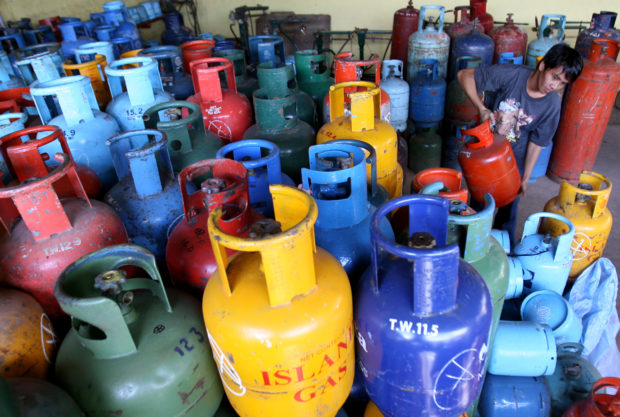Households feel the pinch as LPG prices soar
MANILA, Philippines — For the sixth straight month, the price of LPG increased in November by P3.10 a kilo—or P34.10 for the standard 11-kilo cylinder, prompting Filipino households and even small business owners to adjust their budgets.
Anna Sabater, a mother of three who earns P5,000 a month as a babysitter, said her family had to cut their electricity use to save money.
Her husband works at a printing press where he gets the minimum wage of P537 a day.
“The money we are earning is not enough to make up for our monthly expenses because we need to pay for electricity, water, everyday meals and even LPG,” Sabater told the Inquirer.
Aside from reducing their energy consumption, she also had to plan their meal wisely before going to the wet market. Sabater said she now uses meat as an ingredient when cooking instead of being the main course in her family’s meals.
Article continues after this advertisementAlternative options
“When I cook, I also make sure that it lasts for the entire day so I won’t have to cook again. Whatever our dish is for lunch, it would be the same for dinner,” she added.
Article continues after this advertisementThe successive LPG price increases forced her to save more, she said, noting that “I really need to find alternative ways to make ends meet because of the continuous increase in prices of [other] basic commodities.”
Julie Balingkit, meanwhile, sells rice cakes for extra income. After the LPG price increase in November, she said her P400 profit from selling 50 pieces of “puto” has dwindled to P100.
She recalled buying an LPG cylinder for just P550, which jumped to P720, then P850 and to P890 now. That’s an increase of 61.2 percent.
“The impact [of expensive LPG] was really heavy on my small business of selling rice cakes,” she said.
Increasing the price of the rice cake was not an option, Balingkit added, because the people who regularly order from her might not buy anymore.
The Department of Energy said that the increases in oil prices were due to the sudden spike in global market demand because of the reopening of economies.
Spike in global demand
In a briefer last October, the agency attributed five factors that contributed to the surge that caused the oil price jump last month. These included the increased economic activities, stocking of petroleum supply for the winter season, the shift from fossil fuel to low-carbon energy sources, supply remained unchanged and drilling activities stopped.
The drop in US crude oil production due to Hurricane Ida also contributed to the global oil price increase.
Public utility drivers have also complained about the impact of rising petroleum prices on their income.
Last month, the Department of Transportation said it was looking at fuel subsidies and direct aid to both public utility drivers and passengers to avoid having to increase fares for public transport.
Transportation Secretary Arthur Tugade said the department believed it was “not the right time” to raise fares, with the country’s workforce still barely recovering from the impact of closures and restrictions to businesses and jobs.
This was prompted by the petition of Pasang Masda, along with Alliance of Concerned Transport Organizations, Land Transportation Organization of the Philippines, Federation of Jeepney Operators and Drivers Association of the Philippines and Alliance of Transport Operators and Drivers Association of the Philippines Inc., seeking an increase in minimum fares from P9 to P12 due to rising fuel prices.
In their petition, the groups said the current minimum fare was not enough to even cover jeepney operating costs since the pandemic started.
Congress is also debating on the proposal to lower the excise taxes on oil products to help lower the price of diesel, which is used mainly by jeepney and other public utility drivers.
